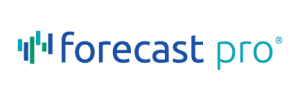Workshop Overview
You will leave this comprehensive three-day educational course with an understanding of forecasting techniques, including how they work and how to apply them in a real business environment. The workshop surveys the most commonly used business forecasting methods, explains how they work conceptually, discusses their pros and cons, and demonstrates best practices for implementing them in a real-world environment using Forecast Pro.
The core of the workshop is 12 hours of live interactive presentations presented over a 3-day period. During the live sessions you will have the opportunity to pose questions to the instructors in real time as well as interact with the other attendees.
The workshop also includes 2 weeks of access to the workshop’s streaming channel and a 2-hour office hours session. The streaming channel provides on-demand access to prerecorded versions of the 9 modules presented in the live sessions along with 3 additional modules not covered in the live sessions. Office hours provide a 2-hour period the week after the live workshop where instructors will be available to answer questions regarding all topics covered in the workshop.
Who should attend?
The workshop is valuable for anyone whose job responsibilities include preparing or analyzing forecasts—some prior knowledge of statistics is helpful but not essential. The tutorials use Forecast Pro and real-world data to provide a deeper understanding of the forecasting methods and to show best practices; these lessons are applicable regardless of which forecasting software your organization uses.
Day 1
Introduction to Forecasting
Exponential Smoothing
Extensions to Exponential Smoothing
Day 2
Forecast Accuracy and Evaluation
Identifying Problems in Your Forecasting Process
Event-Index Models
Day 3
Multiple-Level Forecasting
New Product Forecasting
Virtual Workshop
Additional On-Demand Presentations
Components of Data
Box-Jenkins (ARIMA) Models
Dynamic Regression
Introduction to Forecasting
A broad overview of business forecasting and its various uses within the organization. Topics include approaches to forecasting, features of data, the role of judgment, selection of appropriate forecasting methods for varied data sets and resources for forecasters.
Components of Data
An in-depth look at the different components found in time series data including trends, seasonal patterns, business cycles, trading-day variations, interventions (events) and noise. Discussion includes the forms the components can take, spotting local vs. global components, interpretation of business cycle indicators and the use of decomposition routines.
Exponential Smoothing
A survey of exponential smoothing techniques with particular emphasis on the Holt-Winters family of models and Croston’s intermittent demand model. Topics include the pros and cons of using these models, when they are best used, how they work, identifying model components, parameter optimization and model diagnosis.
Box-Jenkins (ARIMA) Models:
An exploration into the use of ARIMA models for business forecasting. Topics include the advantages/disadvantages of using these models, how and when they should be applied, automatic identification procedures and model diagnostics.
Forecast Accuracy and Evaluation
A detailed look at evaluating the accuracy of forecasting methods. Topics include the distinction between within-sample and out-of-sample errors, a survey of error measurement statistics, a summary of findings from forecasting competitions, and an explanation of how to use both real-time tracking reports and simulations as predictors of model performance.
Identifying Problems in Your Forecasting Process
Approaches for focusing on critical items when forecasting large volumes of data. Topics include evaluating and forecasting SKU data, filtering and ABC (Pareto) classification, outlier detection and correction, exception reporting and measuring accuracy across multiple time series.
Event-Index Models
Event-index models extend the functionality of exponential smoothing models by providing adjustments for promotions, strikes and other non-calendar-based events. This session addresses how these models work, how and when they should be used, and how to customize their design to best suit your needs.
Multiple-Level Forecasting
This session explores hierarchical forecasting techniques. Topics include the need for forecasting at various levels, product vs. geographical hierarchies, reconciliation strategies, top-down vs. bottom-up approaches, the use of proportional allocation and adjustment for seasonality.
New Product Forecasting
This session explores various approaches for forecasting new products. Topics include the pros and cons of different methods based on a product’s classification and a review of popular methods including item supersession, forecast by analogy and the Bass diffusion model.
Dynamic Regression
A detailed look into the ins and outs of regression forecasting. Topics include when regression models are best applied, how to build the models, ordinary least squares, leading indicators, lagged variables, Cochrane-Orcutt models, hypothesis testing and the use of “dummy” variables.
Virtual Workshop
This session provides the opportunity for attendees to discuss their forecasting processes and challenges with the instructors and other attendees. When attendees are willing to share their Forecast Pro projects with the group (there are usually a few who do) we walk through their current approaches and make recommendations for improvements.
Registration
Registration Fee: The registration fee is $495 USD per attendee.
Class size: Due to the interactive nature of the live presentations, attendance is limited to 22 and attendees will be registered on a first-come-first-served basis.
Hours: The workshop will run from 11:00 a.m. to 3:00 p.m. each day (USA Eastern Daylight Time (UTC/GMT -4 hours)). The office hours session will run from 11:00 a.m. to 1:00 p.m on the first Tuesday following the workshop.
Cancellation Policy: The workshop is limited in size and we ask that if you must cancel to please inform us as soon as possible. Attendees may receive a full refund if cancellation is made 14 days or more prior to the start of the workshop. Registrants who fail to attend or cancel less than 14 days before the start date are not entitled to receive a refund. Personnel substitutions may be made at any time.
Instructors
Eric Stellwagen
Eric Stellwagen is
Sarah Darin
Sarah Darin has





